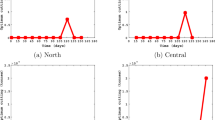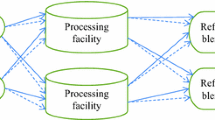Abstract
Sugarcane can play an important role in helping to solve many of the economic and environmental challenges as it has the potential of creating jobs, lowering carbon dioxide emissions, enhancing energy security, and reducing global dependence on fossil fuels. This paper presents a mathematical approach to optimize the Brazilian supply chain (SC) of sugar and bioethanol, using sugarcane as raw material. SC management of sugarcane-based products can be treated as a bi-objective optimization problem with a MILP formulation, in order to find solutions to balance economic profits and environmental damage. A mathematical model is developed and implemented in GAMS, comparing seven different production technologies. The results indicate a set of optimal SC possibilities for the Brazilian scenario and that both quantities and selection of technologies indicated by Pareto optimal solutions are distinguished, outlining three different configurations: environmental, economic, and a balanced scenario. The distribution of technologies in each of the Brazilian regions is presented in these three distinct scenarios indicating that, to approximate the current chain to a balanced solution, it is necessary to migrate technological plants of only sugar products to mixed products technologies (i.e., sugar and bioethanol) and to complement bioethanol production with autonomous distilleries, especially of anhydrous bioethanol production. In this scenario, governmental authorities, sector investors, and decision-makers can plan the implementation of new plants based on the recommendations of this study.
Graphic abstract









Similar content being viewed by others
Abbreviations
- b :
-
Continents for exportation
- i :
-
Materials
- g :
-
Subregion zones
- l :
-
Transportation modes
- p :
-
Manufacturing technologies
- s :
-
Storage technologies
- t :
-
Time periods
- AE:
-
Anhydrous ethanol
- HE:
-
Hydrous ethanol
- LCA:
-
Life cycle assessment
- ALOP:
-
Agricultural land occupation potential (m2a)
- GWP:
-
Global warming potential (kg CO2-Eq)
- FDP:
-
Fossil depletion potential (kg oil-Eq)
- FETP:
-
Freshwater ecotoxicity potential (kg 1,4-DC)
- FEP:
-
Freshwater eutrophication potential (kg 1,4-DC)
- HTP:
-
Human toxicity potential (kg 1,4-DC)
- IRP:
-
Ionizing radiation potential (kg U235-Eq)
- METP:
-
Marine ecotoxicity potential (kg 1,4-DC)
- MEP:
-
Marine eutrophication potential (kg N-Eq)
- MEP:
-
Metal depletion potential (kg Fe-Eq)
- NLTP:
-
Natural land transformation (m2a)
- ODP:
-
Ozone depletion potential (kg CFC-11)
- PMFP:
-
Particulate matter potential (kg PM10-Eq)
- POFP:
-
Photochemical oxidant potential (kg NMVOC)
- TAP:
-
Terrestrial acidification potential (kg SO2-Eq)
- TETP:
-
Terrestrial ecotoxicity potential (kg 1,4-DC)
- ULOP:
-
Urban land occupation potential (m2a)
- WDP:
-
Water depletion potential (m3)
- WS:
-
White sugar
- EL g,g′ :
-
Distance between g and g′
- Pe i,p,g,t :
-
Production rate of material i in technology p in subregion g in time t
- Q i,l,g,g′,t :
-
Flow rate of material i transported by mode l from subregion g′ to current subregion g in time period t
- T :
-
Number of time intervals
- \( \tau \) :
-
Interest rate
- υ c :
-
Impact factor of compound c
- \( \omega_{c}^{ \Pr } \) :
-
Input associated to dataset of compound c in production stage
- \( \omega_{c}^{\text{Tr}} \) :
-
Input associated to dataset of compound c in transportation stage
- C :
-
Cash flow in time t
- DAM:
-
Total damage
- LCIc :
-
Life cycle impact of compound c
- NPV:
-
Net present value
References
Almansoori A, Shah N (2006) Design and operation of a future hydrogen supply chain snapshot model. Chem Eng Res Des 105:423–438. https://doi.org/10.1205/cherd.05193
Bonfim-Rocha L, Gimenes ML, Faria SHB, Silva RO, Esteller LJ (2018) Multi-objective design of a new sustainable scenario for bio-methanol production in Brazil. J Clean Prod 187:1043–1056. https://doi.org/10.1016/j.jclepro.2018.03.267
Bordonal RO, Carvalho JLN, Lal R, De Figueiredo EB, de Oliveira BG, La Scala N (2018) Sustainability of sugarcane production in Brazil: a review. Agron Sustain Dev 38(2):13. https://doi.org/10.1007/s13593-018-0490-x
Cardoso TF, Watanabe MDB, Souza A, Chagas MF, Cavalett O, Morais ER, Nogueira LAH, Leal MRLV, Braunbeck OA, Cortez LAB, Bonomi A (2019) A regional approach to determine economic, environmental and social impacts of different sugarcane production systems in Brazil. Biomass Bioenergy 120:9–20. https://doi.org/10.1016/j.biombioe.2018.10.018
Cavalett O, Junqueira TL, Dias MOS, Jesus CDF, Mantelatoo PE, Cunha MP, Franco HCJ, Cardoso TF, Maciel Filho R, Rossell CEV, Bonomi A (2012) Environmental and economic assessment of sugarcane first generation biorefineries in Brazil. Clean Technol Environ Policy 14:399–410. https://doi.org/10.1007/s10098-011-0424-7
Chagas MF, Bonomi A, Cavalett O (2015) Ethanol life cycle inventory, brazilian center of research in energy and materials [in Portuguese]. https://lnbr.cnpem.br/ethanol-life-cycle-inventory. Accessed 25 May 2019
Christofoletti CA, Escher JP, Correia JE, Marinho JFU, Fontanetti CS (2013) Sugarcane vinasse: environmental implications of its use. Waste Manag 33:2752–2761. https://doi.org/10.1016/j.wasman.2013.09.005
Ecoinvent Centre (2018) The life cycle inventory data, version 3.5. https://www.ecoinvent.org. Accessed 11 Jan 2018
Ehrgott M (2000) Multicriteria optimization. Springer, Berlin
EPE - Empresa de Pesquisa Energética. Balanço Energético Nacional 2016: ano base 2015 (in Portuguese). http://epe.gov.br/pt/publicacoes-dados-abertos/publicacoes/balanco-energetico-nacional-ben. Accessed 11 Jan 2018
Eskandarpour M, Dejax P, Miemczyk J et al (2015) Sustainable supply chain network design: an optimization-oriented review. Omega 54:11–32. https://doi.org/10.1016/j.omega.2015.01.006
Guillén-Gosálbez G, Mele F, Grossmann I (2009) A bi-criterion optimization approach for the design and planning of hydrogen supply chains for vehicle use. AIChE J 56:650–667. https://doi.org/10.1002/aic.12024
Huijbregts MAJ, Steinmann ZJN, Elshout PMF, Stam G, Verones F, Vieira MDM, Hollander A, Zijp M, Van Zelm R (2016) A harmonized life cycle impact assessment method at midpoint and endpoint level. Report I: characterization, Bilthoven, Netherlands
ISO-International Organization for Standardization (2006) Environmental management: life cycle assessment—principles and framework—ISO 14.040, ISO, Genebra
Janke L, Leite A, Nikolausz M, Schmidt T, Jan Liebetrau, Nelles M, Stinner W (2015) Biogas production from sugarcane waste: assessment on kinetic challenges for process designing. Int J Mol Sci 16:20685–20703. https://doi.org/10.3390/ijms160920685
Kostin A, Guillén-Gosálbez G, Mele F, Bagajewicz M, Jiménez L (2011) A novel rolling horizon strategy for the strategic planning of supply chains: application to the sugarcane industry of Argentina. Comput Chem Eng 35:2540–2563. https://doi.org/10.1016/j.compchemeng.2011.04.006
Kostin A, Macowski DH, Pietrobelli JMTA, Guillén-Gosálbez G, Jiménez L, Ravagnani MASS (2018) Optimization-based approach for maximizing profitability of bioethanol supply chain in Brazil. Comput Chem Eng 115:121–132. https://doi.org/10.1016/j.compchemeng.2018.04.001
Mano TB, Jiménez L, Ravagnani MASS (2017) Incorporating life cycle assessment eco-costs in the optimization of heat exchanger networks. J Clean Prod 162:1502–1517. https://doi.org/10.1016/j.jclepro.2017.06.154
Mathivathanan D, Kannan D, Noorul Haq A (2018) Sustainable supply chain management practices in Indian automotive industry: a multi-stakeholder view. Resour Conserv Recycl 128:284–305. https://doi.org/10.1016/j.resconrec.2017.01.003
Mayer FD, Feris LA, Marcilio NR, Staudt PB, Hoffmann R, Baldo V (2015) Influence of fusel oil components on the distillation of hydrous ethanol fuel (hef) in a bench column. Braz J Chem Eng 32:585–593. https://doi.org/10.1590/0104-6632.20150322s00003215
Mele F, Kostin A, Guillén-Gosálbez G, Jimenez L (2011) Multiobjective model for more sustainable fuel supply chains: a case study of the sugarcane industry in Argentina. Ind Eng Chem Res 50:4939–4958. https://doi.org/10.1021/ie101400g7
Muñoz I, Flury K, Jungbluth N, Rigarlsford G, Canals LM, King H (2014) Life cycle assessment of bio-based ethanol produced from different agricultural feedstocks. Int J Life Cycle Assess 19:109–119. https://doi.org/10.1007/s11367-013-0613-1
Novacana (2013) Quatro fatores para entender a crise do etanol (in Portuguese). https://www.novacana.com/n/etanol/mercado/futuro/quatro-fatores-entender-crise-etanol-030513/. Accessed 11 Jan 2018
Oliveira LPN, Rochedo PRR, Portugal-Pereira J, Hoffmann BS, Aragão R, Milani R, Lucena AFP, Szklo A, Schaeffer R (2016) Critical technologies for sustainable energy development in Brazil: technological foresight based on scenario modelling. J Clean Prod 130:12–24. https://doi.org/10.1016/j.jclepro.2016.03.010
Prado RM, Caione G, Campos CNS (2013) Filter cake and vinasse as fertilizers contributing to conservation agriculture. Appl Environ Soil Sci 2013:581984. https://doi.org/10.1155/2013/581984
Ramjeawon T (2004) Life cycle assessment of cane sugar on the island of Mauritius. Int J LCA 9:254–260. https://doi.org/10.1007/bf02978601
Ravagnani MASS, Reis MHM, Maciel Filho R, Wolf-Maciel MR (2010) Anhydrous ethanol production by extractive distillation: a solvent case study. Process Saf Environ 88:67–73. https://doi.org/10.1016/j.psep.2009.11.005
Renó MLG, Lora EES, Palacio JCE, Venturini OJ, Buchgeister J, Almazan O (2011) A LCA (life cycle assessment) of the methanol production from sugarcane bagasse. Energy 36:3716–3726. https://doi.org/10.1016/j.energy.2010.12.010
Renó MLG, Olmo OA, Palacio JCE, Lora EES, Venturini OJ (2014) Sugarcane biorefineries: case studies applied to the Brazilian sugar–alcohol industry. Energy Convers Manag 86:981–991. https://doi.org/10.1016/j.energy.2010.12.010
Renouf MA, Wegener MK, Pagan RJ (2010) Life cycle assessment of Australian sugarcane production with a focus on sugarcane growing. Int J LCA 15:927–937. https://doi.org/10.1007/s11367-010-0226-x
Santibañez-Aguilar JE, Guillen-Gosálbez G, Morales-Rodriguez R, Jiménez-Esteller L, Castro-Montoya AJ, Ponce-Ortega JM (2016) Financial risk assessment and optimal planning of biofuels supply chains under uncertainty. BioEnergy Res 9:1053–1069. https://doi.org/10.1007/s12155-016-9743-16
Seabra JEA, Macedo IC, Chum HL, Faroni CE, Sarto CA (2011) Life cycle assessment of Brazilian sugarcane products: GHG emissions and energy use. Biofuels, Bioprod Biorefin 5:519–532. https://doi.org/10.1002/bbb.289
Silva RO, Torres CM, Bonfim-Rocha L, Lima OCW, Coutu A, Jiménez L, Jorge LMM (2018) Multi-objective optimization of an industrial ethanol distillation system for vinasse reduction: a case study. J Clean Prod 183:956–963. https://doi.org/10.1016/j.jclepro.2018.02.179
UNICA (2017) Sugar cane production in Brazil. Technical report, Sugar cane industry association. http://www.unicadata.com.br/historico-de-producao-e-moagem.php?idMn=32&tipoHistorico=4. Accessed 11 Jan 2018
Witayapairot W, Yossapol C (2009) Life cycle assessment of sugar production in Northeastern Thailand. In: International conference on green sustainable innovation. Chiang Rai, Thailand, 2–4 Dec 2009
Yoshizaki HTY, Muscat ARN, Biazzi JL (1996) Decentralizing ethanol distribution in southeastern Brazil. Interfaces. 26:24–34. https://doi.org/10.1287/inte.26.6.245
Zhang Y, Kendall A (2017) Life cycle performance of cellulosic ethanol and corn ethanol from a retrofitted dry mill corn ethanol plant. BioEnergy Res 10:183–198. https://doi.org/10.1007/s12155-016-9776-5
Acknowledgements
The authors wish to acknowledge the financial support received from the Brazilian National Council for the Development of Science and Technology (CNPq) and from the Brazilian Coordination for the Improvement in Higher Education Personnel—Process 88881.171419/2018-01 (CAPES).
Author information
Authors and Affiliations
Corresponding author
Additional information
Publisher's Note
Springer Nature remains neutral with regard to jurisdictional claims in published maps and institutional affiliations.
Electronic supplementary material
Below is the link to the electronic supplementary material.
Rights and permissions
About this article
Cite this article
Macowski, D.H., Bonfim-Rocha, L., Orgeda, R. et al. Multi-objective optimization of the Brazilian industrial sugarcane scenario: a profitable and ecological approach. Clean Techn Environ Policy 22, 591–611 (2020). https://doi.org/10.1007/s10098-019-01802-0
Received:
Accepted:
Published:
Issue Date:
DOI: https://doi.org/10.1007/s10098-019-01802-0




